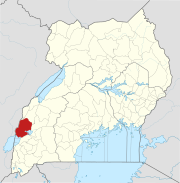Hima Cement Limited
| Type | Subsidiary |
|---|---|
| Industry | Manufacturer and distributor of cement |
| Founded | 1994 |
| Headquarters | Hima, Uganda |
Key people | Nicolas George Managing Director[1] |
| Products | Cement |
Number of employees | 700+ (2011) |
| Parent | Holcim Group |
| Website | Homepage |
Hima Cement Limited (HCL) is a cement manufacturer in Uganda. It is a subsidiary of the Holcim Group, a building materials manufacturer headquartered in Switzerland, with subsidiaries in over 80 countries.[2]
Location[]
The main factories of HCL are located in Hima in Kasese District in the Western Region of Uganda. This is approximately 23.5 kilometres (15 mi), by road, northeast of Kasese, the nearest large town and the location of the district headquarters.[3] Hima is approximately 350 kilometres (217 mi), by road, west of Kampala, the capital and largest city of Uganda.[4] The geographical coordinates of the main factory are: 0°17'21.0"N, 30°10'45.0"E (Latitude:0.289167; Longitude:30.179167).[5]
In 2018, HCL opened a new US$40 million cement factory along the Tororo-Mbale-Soroti Road, with production capacity of 850,000 tonnes (936,965 tons) annually, to match the output from Kasese District.[6] The new factory will increase total output for Hima Cement Uganda Limited to 1,900,000 tonnes (2,094,391 tons) annually.[6] The Tororo factory of Hima Cement Limited came online in 2018.[7]
Overview[]
As of 2019, HCL was the second-largest manufacturer of cement in Uganda, producing an estimated 2 million metric tonnes annually, accounting for 28 percent on national output. 20 percent of Hima's production was exported to South Sudan, the Democratic Republic of the Congo and Rwanda.[8]
In addition to the factories in Hima and Tororo, HCL maintains a corporate office in Twed Towers, Kafu Road, in Kampala and two warehouses, one in Kampala's industrial area and the other in the eastern border town of Tororo. HCL also owns a limestone quarry at Dura in the Kamwenge District, which supplies the limestone used in cement manufacturing. The quarry is estimated to contain enough limestone to sustain current production capacity until 2036.[9]
History[]
In 1994, the parastatal formerly known as Uganda Cement Industries was privatized by the government of Uganda. It was split into Tororo Cement and Hima Cement. The two companies were acquired by different investors. Tororo Cement eventually became Tororo Cement Limited. In 1999, the French conglomerate LaFarge acquired 100 percent shareholding in Hima Cement and re-branded the company into Hima Cement Limited. Production capacity at the HCL's factories increased steadily from the 20,000 metric tonnes in 1994 to 850,000 tonnes in 2011. In 2018, total production capacity at both factories in Hima and Tororo, in Uganda was 1,700,000 tonnes (1,873,929 tons) annually.[10]
Supply contracts[]
In July 2017, HCL signed a memorandum of understanding with the China Communications Construction Company to supply 120,000 metric tonnes of cement for three public projects as follows: 1. Over the next five years, HCL will supply 30,000 metric tonnes of cement (60 percent of the project requirements) for the ongoing expansion of the Entebbe International Airport. 2. Over the next three years, HCL will supply 60,000 metric tonnes of cement for the Mubende-Kakumiro-Kagadi Road. 3. Over the next three years, HCL will supply 30,000 metric tonnes of cement for the Tororo-Mbale-Soroti Road.[11] 4. Hima Cement has been the largest supplier of cement during the construction of the 600 megawatts Karuma Hydroelectric Power Station, between 2013 and 2020.[2]
Ownership[]
HCL is a subsidiary of Holcim, a large Swiss-based buildings material conglomerate. The table below illustrates the shareholders in Hima Cement Limited.[12][13]
| Rank | Name of Owner | Number of shares | Percentage Ownership |
|---|---|---|---|
| 1 | Himcem Holding Limited | 1,335,600 | |
| 2 | Cem Holdings Limited | 572,400 | |
| Total | 1,908,000 |
References[]
- ^ Mukami, Lynette (9 February 2018). "Bamburi Cement names new boss". Business Daily Africa. Nairobi. Retrieved 9 February 2018.
- ^ a b LafargeHolcim (15 April 2019). "LafargeHolcim through its local actor Hima Cement helps power a more sustainable Uganda". Jona, Switzerland: LafargeHolcim. Retrieved 4 June 2020.
- ^ Google (4 June 2020). "Road Distance Between Kasese And Hima In Uganda" (Map). Google Maps. Google. Retrieved 4 June 2020.
- ^ Google (4 June 2020). "Road Distance Between Kampala, Uganda and Hima, Uganda" (Map). Google Maps. Google. Retrieved 4 June 2020.
- ^ Google (4 June 2020). "Location of Hima Cement Uganda Limited, Hima Uganda" (Map). Google Maps. Google. Retrieved 4 June 2020.
- ^ a b Mark Keith Muhumuza (20 January 2017). "Cement companies rush to set up new plants in Tororo". Daily Monitor. Kampala. Retrieved 4 June 2020.
- ^ Joseph Omollo and Fred Wambede (8 May 2018). "Tororo rises from the dust as new cement factories open". Daily Monitor. Kampala. Retrieved 4 June 2020.
- ^ Dorothy Nakaweesi (16 April 2019). "Cement export earnings rise by 25 percent". Daily Monitor. Kampala. Retrieved 4 June 2020.
- ^ Hope Mafaranga (15 August 2011). "Quarry Boosts Hima Cement Output". New Vision. Kampala. Retrieved 4 June 2020.
- ^ Hima Cement Limited (4 June 2020). "Hima Cement Limited: About Us". Hima, Uganda: Hima Cement Limited. Retrieved 4 June 2020.
- ^ Julius Barigaba (27 July 2017). "Hima pulls ahead in race for Uganda's large infrastructure projects". The EastAfrican. Nairobi. Retrieved 4 June 2020.
- ^ Hima Cement Limited (5 June 2020). "Hima Cement Limited Ownership". Hima, Uganda: Hima Cement Limited. Retrieved 5 June 2020.
- ^ Halima Abdallah (24 September 2016). "Hima Cement to invest $40m in new Tororo plant". The East African. Nairobi.
- Cement companies of Uganda
- Kasese District
- Manufacturing companies established in 1994
- 1994 establishments in Uganda
- Holcim Group

